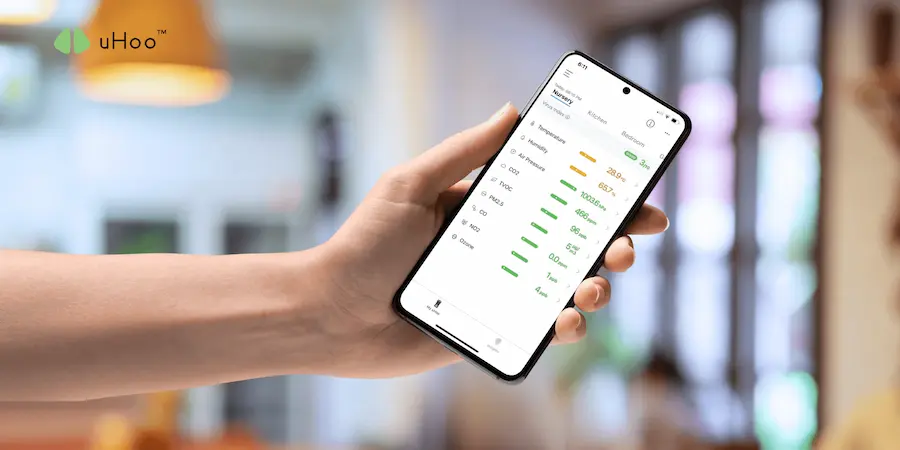Summer’s warmth is a welcome relief for many, but it often brings a significant challenge for our respiratory health: increased ground-level ozone pollution. This invisible, irritating gas, a primary component of smog, forms rapidly when pollutants react in sunlight and, crucially, high heat.
Don’t let unhealthy air dampen your summer enjoyment! Here are 7 essential air quality tips to help you effectively combat both heat and ozone and maintain a healthier home.
- Monitor Local Air Quality Daily and Proactively: Your uHoo app should be your first point of reference every morning, especially during warmer months. It can integrate with local air quality forecasts and real-time data from environmental agencies, providing you with up-to-date information on ozone levels in your area. Make it a habit to check before planning any outdoor activities or opening windows. Knowing when ozone levels are predicted to be high is the most critical of all air quality tips as it enables you to take preventive action.
- Seal Your Home Tightly to Prevent Infiltration: When outdoor ozone levels are elevated (as indicated by your uHoo app or local alerts), your home acts as your primary shield. Keep all windows and doors firmly closed. Pay attention to any drafts or visible gaps around door and window frames – even small openings can allow significant amounts of ozone-rich outdoor air to seep inside. Consider using simple weatherstripping or door sweeps to enhance your home’s seal, especially during peak ozone hours.
- Utilize Your HVAC System as a Protective Barrier: Running your central air conditioning (AC) system serves a dual purpose during heatwaves. Firstly, it keeps your home cool and comfortable, reducing the need to open windows. Secondly, and just as importantly, it helps to filter out some outdoor pollutants as it circulates and conditions indoor air. Ensure your HVAC filters are clean and consider using higher-efficiency filters (like MERV 8 or above) which can trap more fine particulate matter, contributing to overall better indoor air quality, even if they don’t directly remove ozone gas.
- Avoid Strenuous Outdoor Activities During Peak Ozone Hours: Ozone concentrations typically peak in the afternoon and early evening (often between 1 PM and 7 PM) when sunlight and heat are most intense. If outdoor ozone levels are high, reschedule vigorous outdoor exercises, yard work, or prolonged play for children to the early morning or late evening. For less strenuous activities, stay in shaded areas. This is one of the most effective air quality tips for minimizing personal exposure.
- Choose Ozone-Free Air Purifiers and Appliances: Not all air purifiers are beneficial. Some can actually worsen your air quality. Be extremely cautious of “air purifiers” or “ionizers” that claim to generate ozone to clean the air – these devices introduce a harmful pollutant directly into your home and should be avoided. Always opt for air purifiers that use true HEPA and activated carbon filtration and are certified as ozone-free. Similarly, be aware that some older laser printers and photocopiers can emit small amounts of ozone. Ensure adequate ventilation if you use them, but only when outdoor ozone is low.
- Reduce Your Personal Contribution to Ozone Formation: While individual actions might seem small, collectively they make a difference. On high-ozone days, try to reduce activities that contribute to ozone-forming emissions. This includes driving less (carpool, use public transport, walk, or bike), refueling your car in the evening when temperatures are cooler (to reduce gasoline vapor evaporation), and choosing low-VOC (Volatile Organic Compound) paints and household cleaners.
- Trust Your uHoo Data for Real-Time Insights: Your uHoo air quality monitor provides crucial real-time insights into your indoor air. While ozone primarily originates outdoors, your uHoo can help you detect if it’s infiltrating your home. By seeing your indoor ozone levels, you gain immediate feedback on the effectiveness of your protective measures. If ozone levels are still rising despite your efforts, your uHoo can alert you, allowing you to fine-tune your strategies (e.g., further sealing, adjusting HVAC settings) and ensure these air quality tips are truly working for you.
By consistently applying these comprehensive air quality tips, you can significantly reduce your exposure to ozone and other pollutants, ensuring healthier and safer air for you and your family, even during the hottest and most challenging days of summer.

